-
Close gaps with high-quality dental implants
Implantology
Implantology
Close gaps with high-quality dental implants
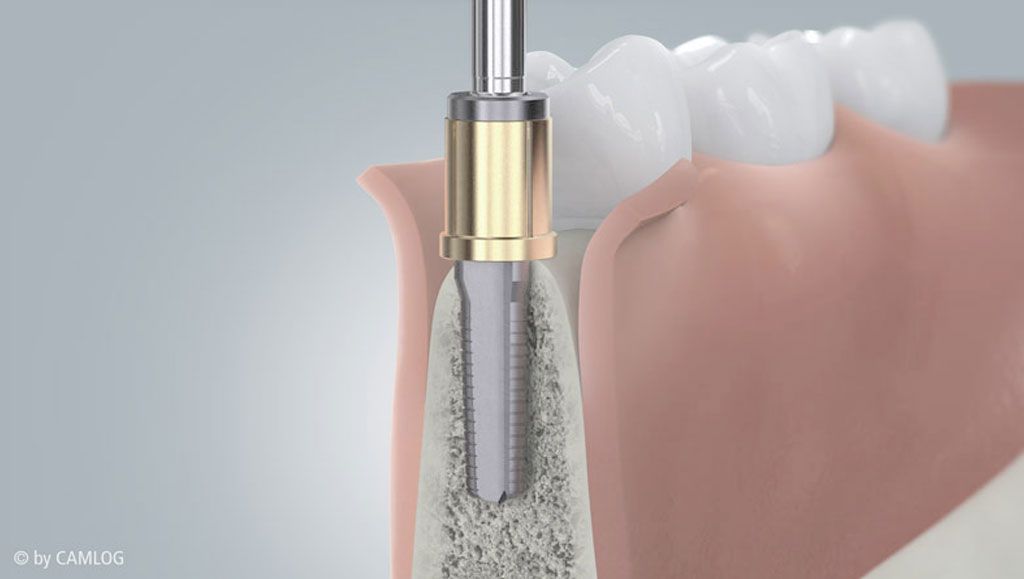
With the introduction of implantology, the possibilities of dentistry have expanded considerably. Today, dental implants are standard and in many cases the most effective solution to many problems. They are a modern and aesthetically-demanding possibility to replace single teeth, whole rows of teeth or even all teeth in function and aesthetics. Another advantage of implants: Neighboring teeth do not have to be ground off and implants can be inserted in such a way that even extensive prostheses have a stable hold.
A prerequisite for the placement of an implant is a healthy, well developed jawbone. The implant site must provide a secure long-term hold. Due to tooth loss, however, the bone is often already degraded and previous interventions can also damage the bone. In implantology, bone augmentation therefore plays a central role. The implantologist treating the patient must therefore have an excellent command of bone augmentation, implantation and soft tissue surgery.
In our specialist practice for oral and maxillofacial surgery with a focus on implantology, we have a great deal of experience in implantation and bone augmentation. We are specialists for bone augmentation with all common procedures and use synthetic bone substitute materials as well as the body’s own materials. Implantological procedures are routine for us. We use state-of-the-art diagnostic procedures such as digital volume tomography (DVT) to plan our procedures and make them predictable and safe. We combine this diagnostic procedure with innovative surgical techniques such as guided bone regeneration (GBR). Minimally invasive soft tissue procedures are an important part of our treatment process. Many years of experience and mastery of advanced surgical techniques in implantology make us the ideal partner for patients and colleagues.
Planning the implantation with the latest DVT technology
Careful planning of the implantation prevents many errors in advance. In our specialist practice for oral and maxillofacial surgery, we rely on 3D implant planning. Thanks to digital volume tomography (DVT), it is possible to create a highly efficient and reliable basis for planning implantations. The results of the DVT are so precise and meaningful that our specialist can assess the available bone supply very well. If bone augmentation is necessary for the insertion of the implant, this can be clearly seen in the images. If no bone augmentation is required, DVT implant planning can be used to ensure effective use of the existing jaw bone. Three-dimensional planning also permits precise positioning of the implant in order to ensure an aesthetically high-quality prosthetic restoration at a later date. DVT thus optimally complements our many years of experience with data that contributes to the highest possible safety and predictability for our patients.
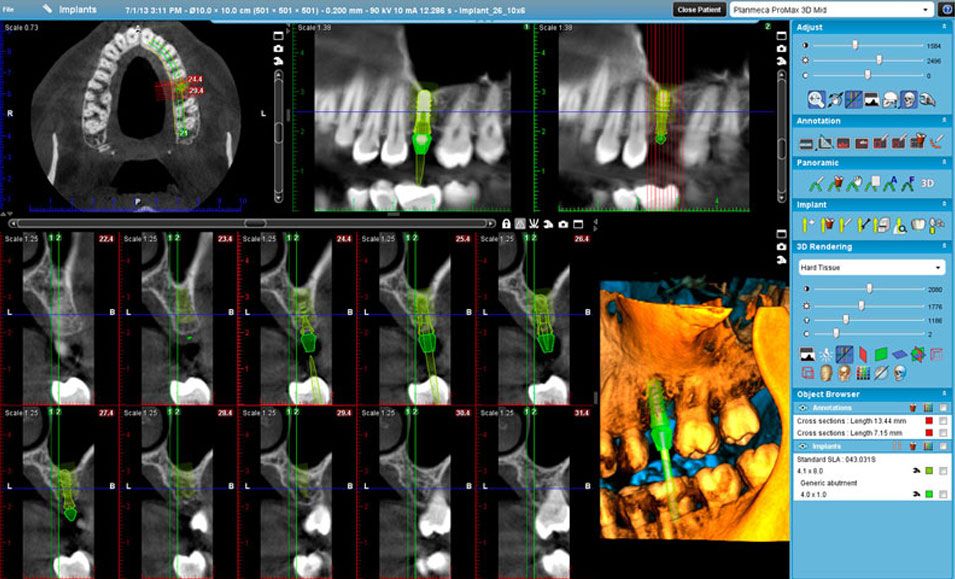

Dental implants – dental prostheses modelled on nature
A dental implant is an artificial tooth root. The model for this artificial tooth root is nature. Implants restore the functions of natural teeth. Compared to many other possibilities of tooth replacement, implants represent a particularly effective solution for closing tooth gaps. Whether a single implant, a bridge supported by an implant or an extensive dental prosthesis, almost all dental prosthesis measures can be supported by dental implants. Thanks to state-of-the-art techniques, such as working with digital volume tomograph, predictable results can be achieved with implants. Thanks to 3D implant planning, implant restoration is a quick and safe solution for replacing missing teeth.
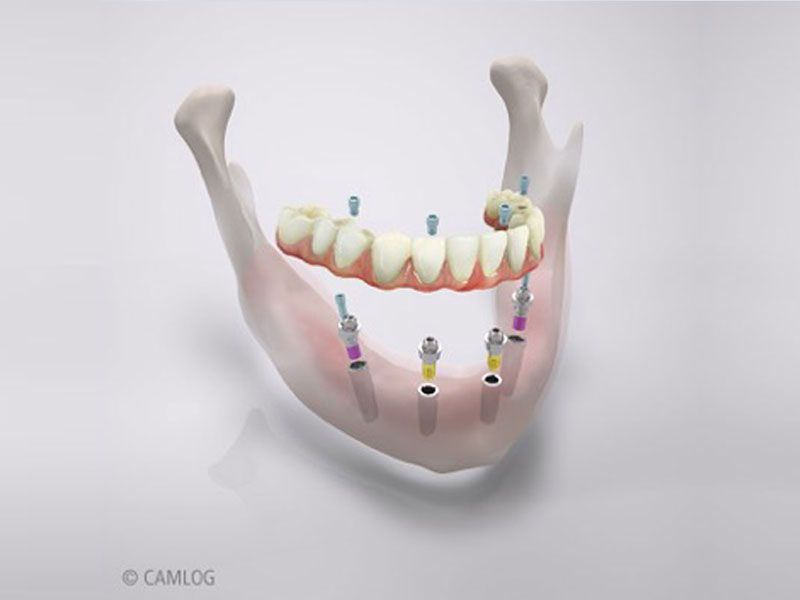
Four implants for a secure hold
A table with four legs has a secure stand and offers sufficient stability to support a solid table top. If the upper or lower jaw or both jaws have to be treated with an extensive dental prosthesis, then, as with the stability of a table, a secure hold is essential. A single implant clearly provides too little support for dental prostheses, such as removable or fixed prostheses. The same applies to two and three implants. Optimum statics for extensive dental prostheses can only be achieved with four implants. With four implants and 3D planning using DVT, the precise and parallel placement of these four necessary implants can be reliably achieved. Thanks to many years of experience, we achieve the greatest possible stability here.
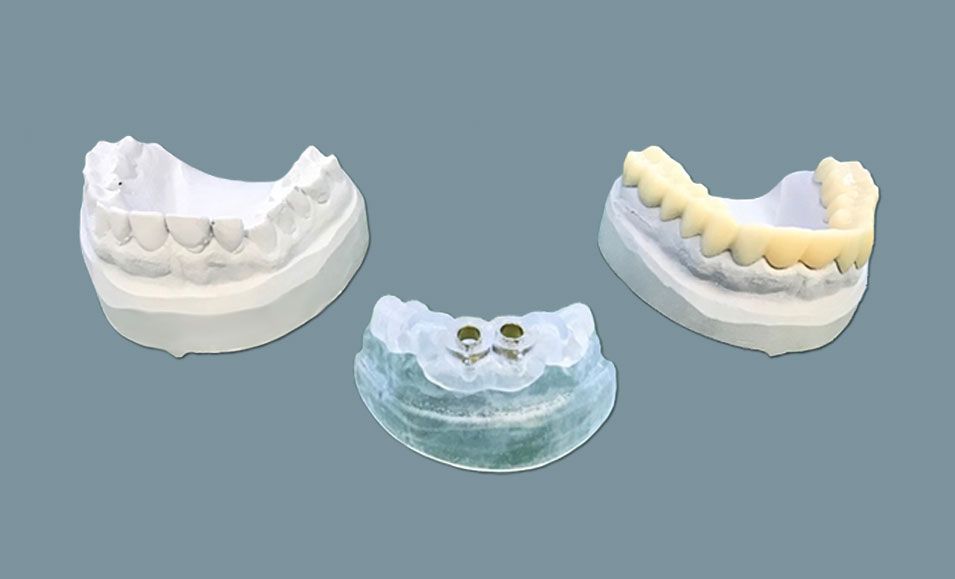
Immediate implant placement – is that possible?
Immediate implantation is when a tooth is removed within a treatment appointment and immediately treated with a dental implant. It is not only possible to implant immediately and not plan another procedure for it, this procedure is often particularly useful. In many cases the tooth is extracted, then the bone has to heal and in the next step the bone is prepared for the implant. This procedure is still practiced as a standard procedure. However, the implant can also be inserted when the tooth is removed. Prerequisite for this: the bone is sufficiently high and thick and there is no inflammation either on the bone or on the soft tissue. Such immediate implants save time and provide an optimal aesthetic result. With our many years of experience and modern equipment, we accompany our patients to results that leave nothing to be desired, even during immediate implant placement.
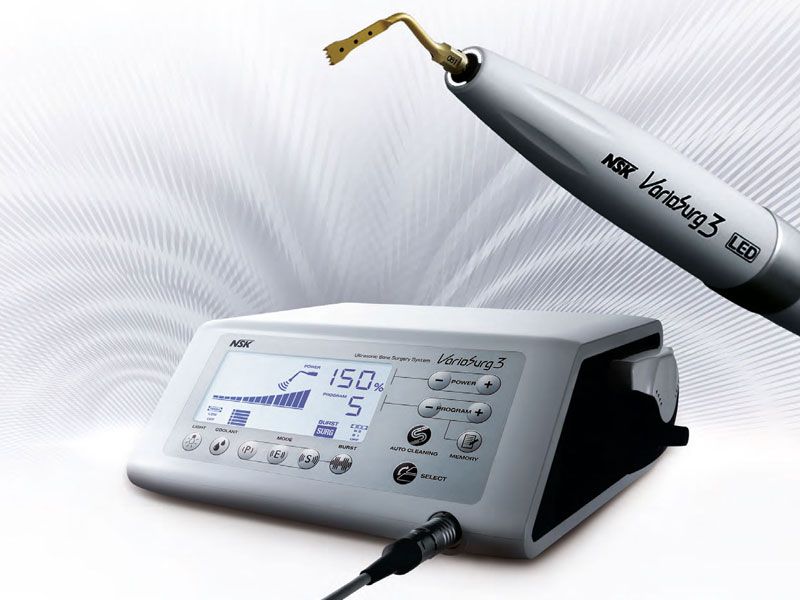
Making room for the implant
When a tooth has to be removed, there is always a serious reason for it. The implant is an effective solution to close the gap. However, in order to ensure the best possible results, the extraction of the tooth must be carefully planned. In many cases an osteotomy is necessary. Here, for example, tooth fragments that are wrongly positioned, severely destroyed or remaining in the jaw are removed by surgery. Osteotomy is necessary to prevent inflammation. With us, the planning of an implantation already begins with the extraction of the tooth. We also focus on gentle treatment of bone and soft tissue. Precise diagnostic procedures such as DVT and gentle techniques such as ultrasound surgery (piezo surgery) support our cautious approach. If an immediate transplantation is not possible, we still start the bone augmentation with bone substitute material or another suitable technique at the first operation. Hard and soft tissue are thus optimally prepared for implantation.
Bone augmentation for implant preparation
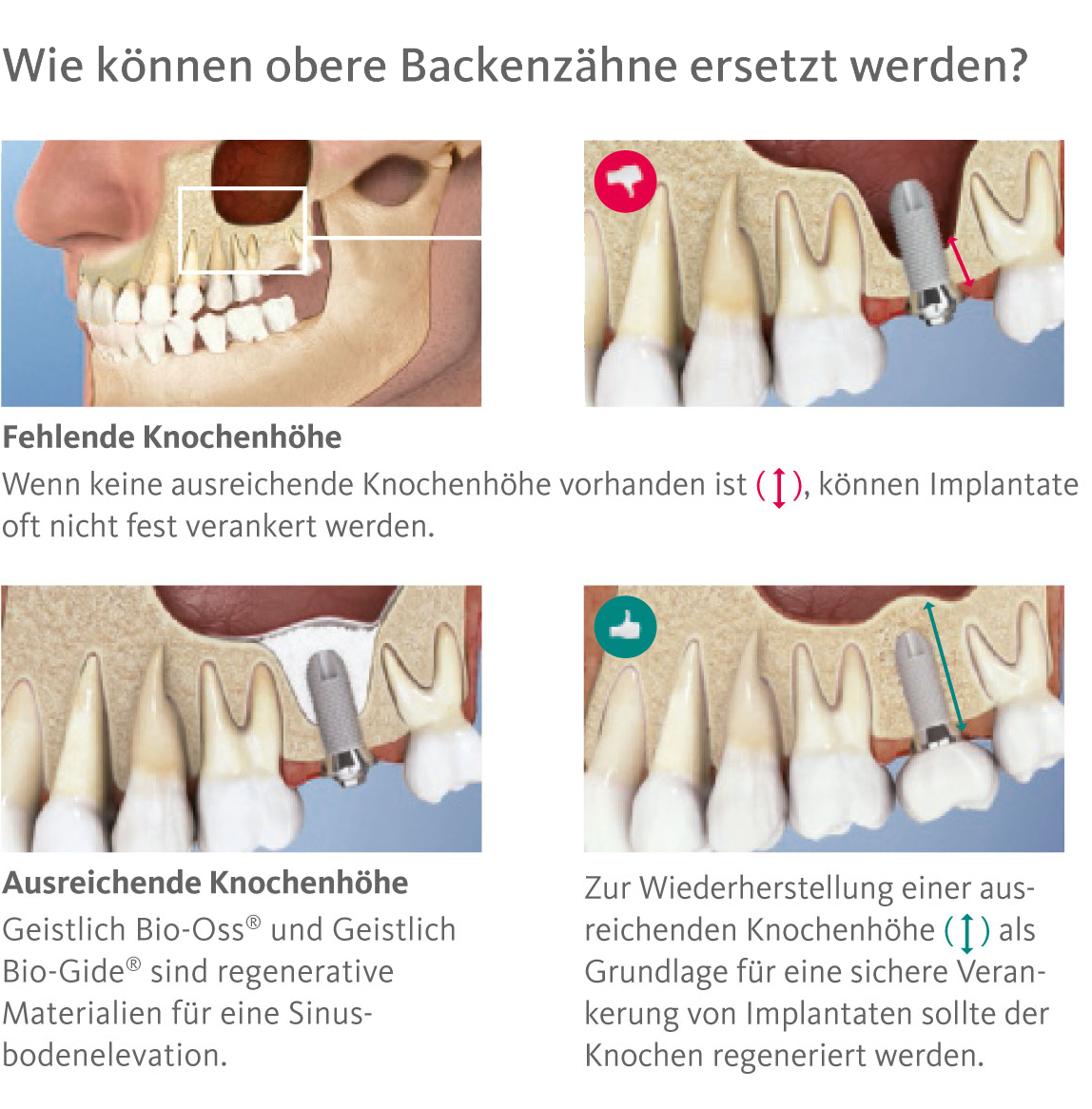
Sinus lift – if the bone in the upper jaw is insufficient
A special type of bone formation in the upper jaw is the elevation of the maxillary sinus arch, the so-called sinus lift. In many cases, the bone supply in the posterior region (molars) of the upper jaw is not sufficient to secure an implant safely and long-term. Sinus lift is then often the only way to create sufficient bone material for implantation and fixed dentures. In sinus lift, the bony floor of the maxillary sinus is lifted and thickened.
In this way, the bone volume is increased. Even though this procedure is technically demanding and requires a great deal of experience from the surgeon, it is now routine in our specialist practice for oral and maxillofacial surgery. We use ultrasound surgery to make the sinus lift minimally invasive and can perform bone augmentation and implantation within one session. Bone replacement materials are usually sufficient for bone augmentation in the maxilla.
Guided bone regeneration – what are the advantages of this procedure?
Guided bone regeneration (GBR) is a process that stimulates the body to regenerate lost bone substance. Guided bone regeneration can be used, for example, when a tooth loses its hold in the jawbone. Guided bone regeneration is also used in implantology if the implant site is too weak to accommodate the implant. Non-absorbable bone replacement material is then used to create an artificial cavity. The bone is stimulated to heal into this cavity. The area is closed with a membrane. The membrane protects the area and prevents connective tissue from forming instead of bone. Guided bone regeneration is opposed to classical transplantation. The great advantage of guided bone regeneration is obvious. The required bone material is formed by the body itself. The newly grown bone thus forms a stable, secure basis for the long-term retention of the implant.

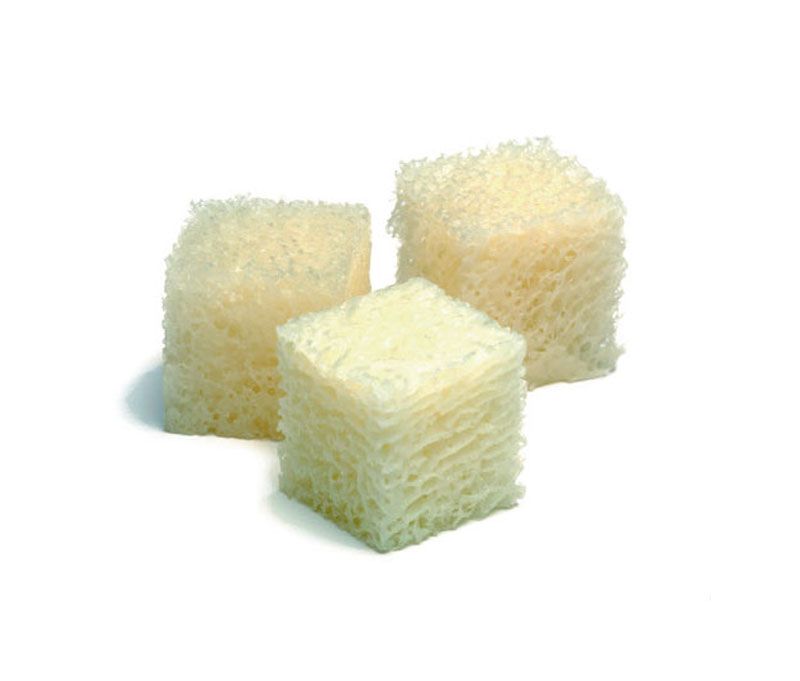
When is a classic block graft necessary?
Today, there are numerous surgical procedures to make bone augmentation as minimally invasive as possible. Nevertheless, there are medical reasons for the use of transplants, especially for larger bone requirements. For larger bone defects, there is the option of using transplanted bone blocks from the patient’s own bone to construct the bone. These so-called block grafts are preferably taken from the wisdom tooth region and then screwed to the jawbone. The bone blocks heal completely within 14 – 16 weeks. For the patient, the discomfort after the operation should be kept as low as possible. This is achieved by obtaining the transplants with the help of ultrasound surgery (piezo surgery) via a minimally invasive access in the jaw angle. Combined with guided bone regeneration, the reconstruction of the jaw can also be carried out for larger bone defects.

Allograft – when the jaw bone has shrunk considerably
In dentistry, an allotransplantation is when bone tissue from another person is implanted into a patient. The transferred bone tissue is called allograft. This procedure makes sense if the jawbone has shrunk so much that the implant cannot find the required secure hold through conventional bone augmentation with autogenous bone or bone substitute materials. In these rare cases, allogeneic bone grafts can be used. Allografts undergo various preparation procedures before use to ensure the best possible processing properties. If there is insufficient bone in the upper and lower jaw, more extensive bone augmentation is usually achieved by removing bone from the iliac crest.
However, this is associated with some disadvantages. The bone harvesting procedure can be very stressful for the patient and takes a lot of time. Allograft is a real alternative here. We work with allogeneic bone grafts, which are produced using CAD/CAM technology on the basis of 3D radiographs. This guarantees a high accuracy of fit. Since this is a comparatively expensive procedure and bone from a donor is used, bone augmentation using allograft can only be considered for a clear medical indication if all other bone augmentation methods do not promise success at the same time.
Beautiful gums for more aesthetics
When inserting an implant, it is not only the firm anchorage and secure hold in the jawbone that are important. Of course, the implant must be fully functional. However, an implant should also fit perfectly into the row of teeth.
This applies in particular to the clearly visible front teeth.
In addition to the white aesthetics (crown, denture), special attention must be paid to the red aesthetics (gums) in implantology. The correction of the gums can be a special challenge and requires a great deal of experience from the surgeon and a high load-bearing capacity from the patient.
For this reason, in our specialist practice for oral and maxillofacial surgery, we focus on immediate implantation and restoration with a fixed temporary. This preserves the soft tissue which is so important for aesthetics and makes gum correction superfluous.

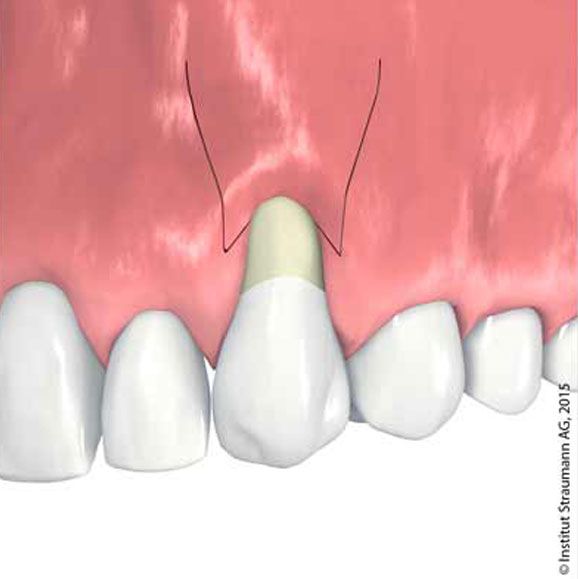

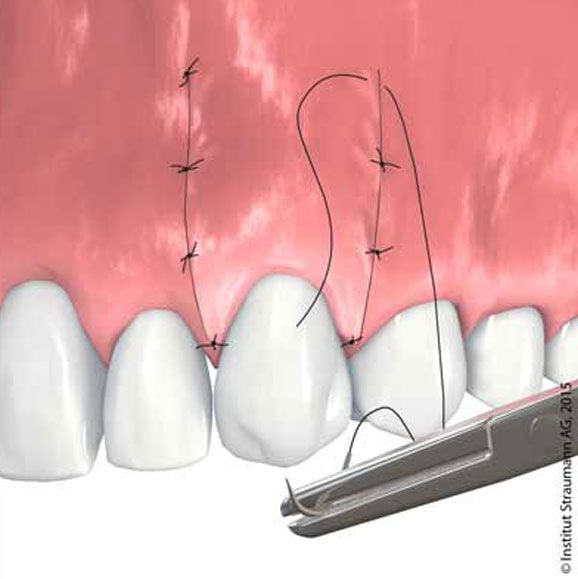
Less pain and faster healing thanks to radio-frequency surgery
There are also situations in which there is no way of avoiding soft tissue correction. This is often the case when bone augmentation has been performed prior to implantation. Ultra-high-frequency radio-frequency surgery facilitates corrections to soft tissue enormously.
The advantages of this procedure are obvious:
- With this technique, the treatment of a narrowly defined tissue space is possible.
- This protects adjacent tissue.
- Only minor bleeding occurs, which allows better vision during surgery.
- this enables highest precision during surgical intervention.
- less swelling after the operation.
- optimal wound healing and an accelerated healing process is the result.

Regenerative implantology – for optimal wound healing
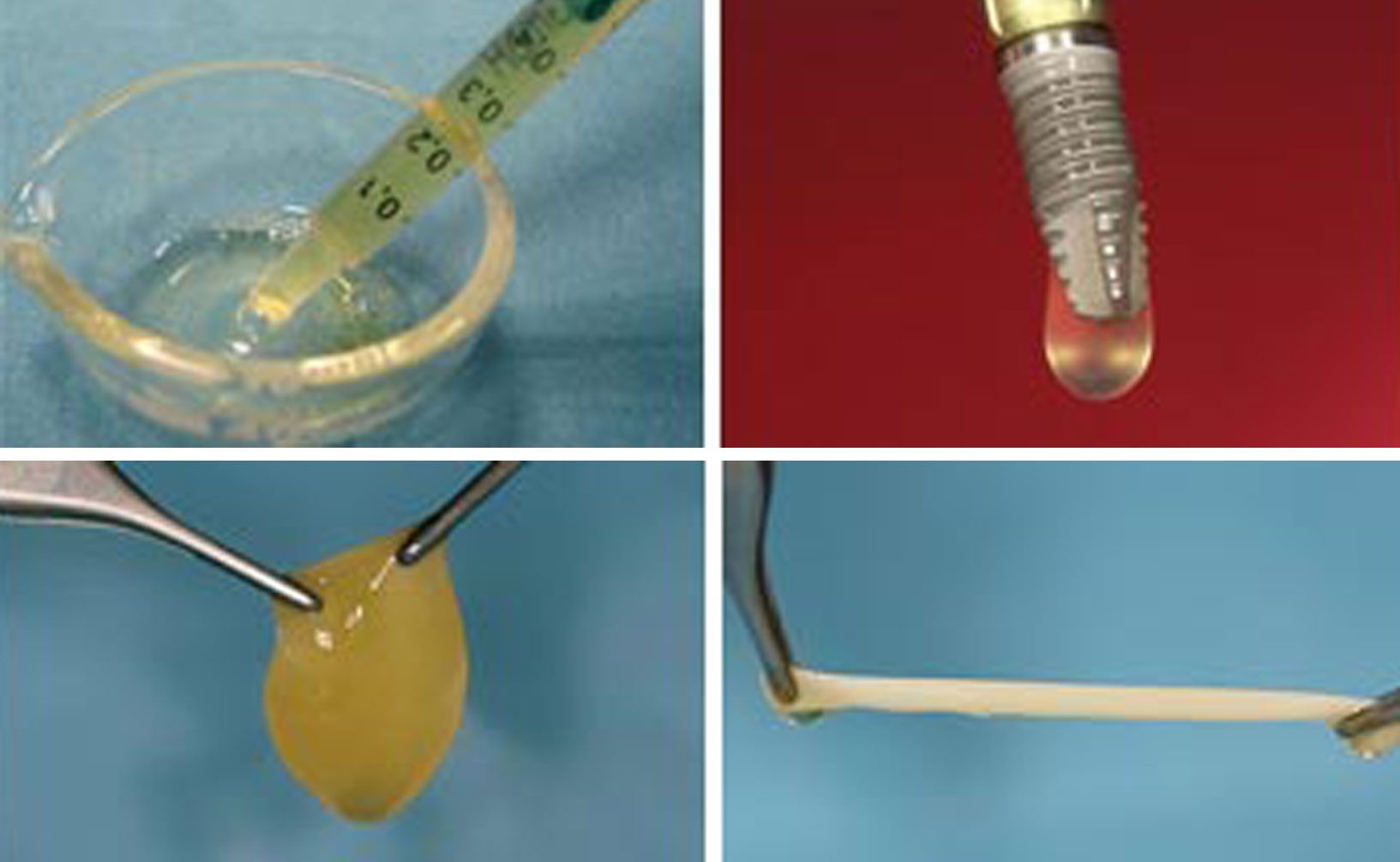
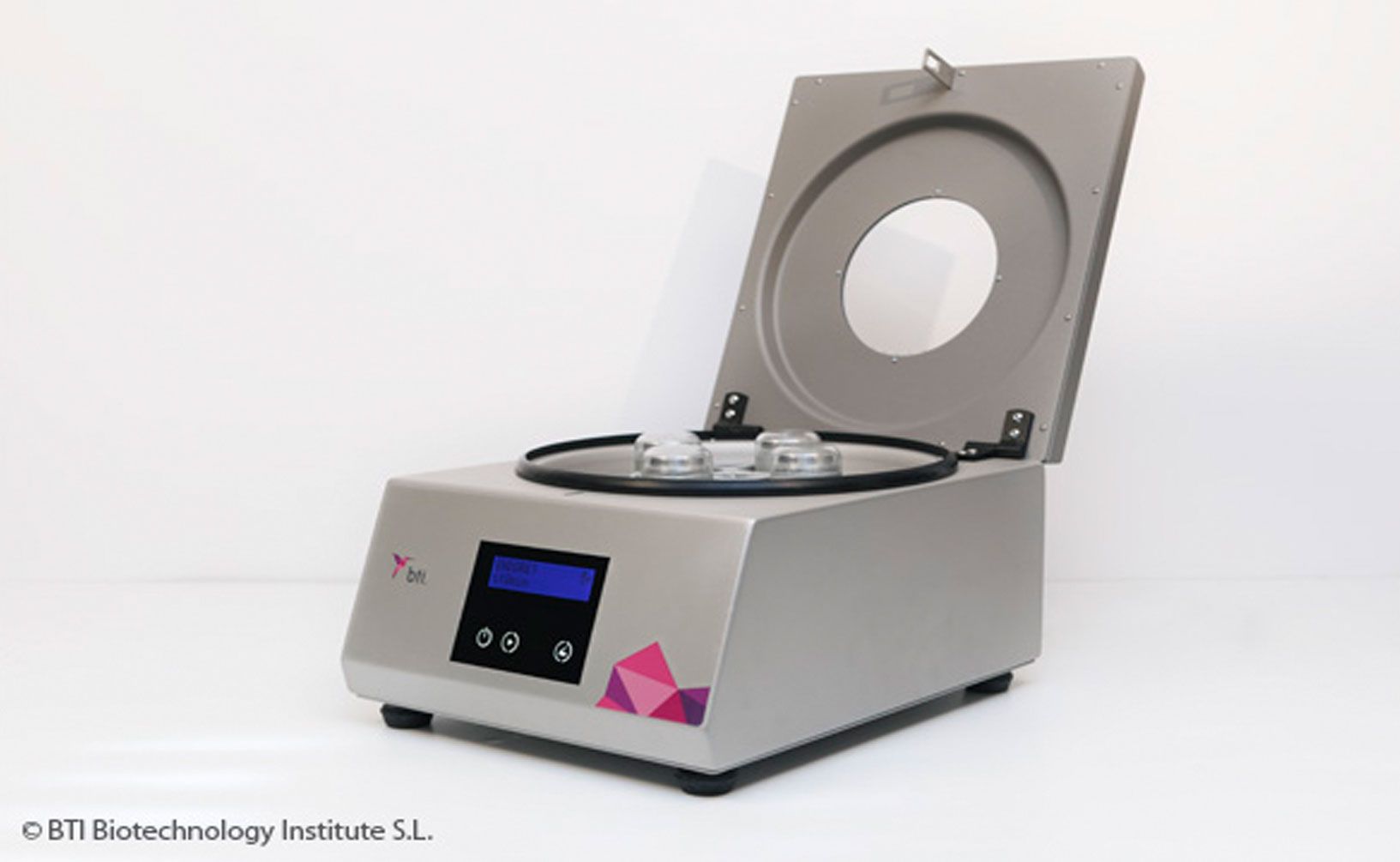
In extensive procedures and complex bone reconstruction therapies, it takes some time until the tissue around the surgical area is optimally supplied with blood again. Ranging from a few days to a few weeks. During this time, there is a risk of wound infection. In order to ensure an uncomplicated healing process after the operation, it is crucial that the surgical area is supplied with blood as quickly as possible. The better a wound area is supplied with blood, the faster the healing process usually progresses.
For this reason, implantations, jaw augmentations and tooth extractions are nowadays often carried out with activated blood platelets in the PRP procedure (or PRGF procedure = Plasma Rich in Growth Factors”). PRP stands for Platelet Rich Plasma. The growth factors contained in platelet-rich blood plasma accelerate wound healing and tissue regeneration and reduce pain and the risk of postoperative swelling and inflammation.
At the beginning of PRP treatment, a small amount of blood is collected from the patient and processed in a centrifuge. In this way, platelet-rich plasma is obtained from the patient’s blood. The blood plasma thus obtained is applied to the implant. The implant is then inserted into the jaw and faster wound healing and regeneration of tissue and bone and complication-free healing of the implant follow.
In our specialist practice for oral and maxillofacial surgery we have a lot of experience with the PRP procedure and appreciate the potential that the promotion of natural wound healing offers us.
Temporary restoration for the healing period
Although an implant is one of the most effective solutions for closing one or more tooth gaps, the procedure also involves a certain amount of treatment time. Many patients worry that they will have to live with a gap for days or even weeks. We would like to provide patients a temporary solution during the healing phase as well. Transparent splints with one tooth, individually adapted prostheses or temporary implants are suitable for temporarily closing the gap. In our practice, we can also make 3D impressions in order to fabricate the most demanding temporary restorations using CAD/CAM technology. Thus, the quality of life during the treatment is not clouded by a disturbing tooth gap.
Would you like a personal consultation? Our practice team will be happy to discuss your concerns in detail with you.
This might also be of interest to you
Dr. med. Sven Heinrich
Specialist for oral and maxillofacial surgery
plastic and aesthetic operations
– Focus of activities: implantology –
Address:
Friedrichstraße 63
(Entrance Mohrenstraße 17)
10117 Berlin
Opening hours
Mo. to Thu.:
08:00 – 18:00 o’clock
Friday by arrangement
Contact us
Phone: +49 (0) 30 / 84 52 48 88
Email: post@dr-heinrich.berlin
Appointment: arrange here



